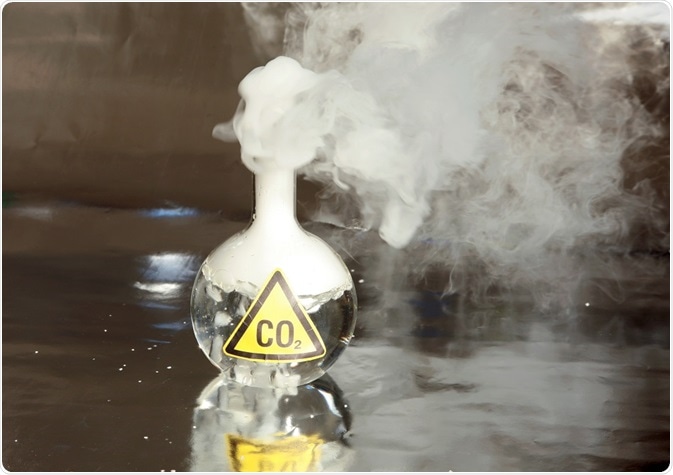Supercritical fluid
For every substance there exists a critical temperature Tc above which it cannot remain a liquid, irrespective of the increasing pressure. Similarly, there exists a critical pressure Pc above which it cannot remain as a gas, irrespective of the increasing temperature.
 Credit: mikeledray/ Shutterstock.com
Credit: mikeledray/ Shutterstock.com
So by maintaining the temperature and pressure of a substance above both Tc and Pc, we will have a substance that has properties intermediate between a liquid and a gas. A substance in that state is called a supercritical fluid. Carbon dioxide and water are two commonly used supercritical fluids.
Properties of supercritical fluids
Supercritical fluids show certain properties that are used to advantage in chromatographic separations:
- No liquid/gas phase boundary and therefore no surface tension
- Solute solubility increases with increase in fluid density
- Fluid density increases with pressure, therefore solute solubility increases with pressure
- At constant density, solute solubility increases with temperature
- Solvating power similar to organic solvents but higher than those of gases
The solvating power of supercritical fluids is proportional to its density, which in turn can be increased by increasing the system pressure.
Components of interest can be made to elute by adjusting these parameters. The whole process is comparable to temperature programming in gas chromatography (GC) or to solvent gradient elution in high pressure liquid chromatography (HPLC).
Components of a supercritical fluid chromatography (SFC) system
The instrumentation setup in an SFC system is similar to that of an HPLC system. But temperature and pressure being two important parameters for a supercritical fluid, there is a heat control system (as in GC) as well as a restrictor (or a pressure control system).
A microprocessor system that collects pressure and oven temperature data as well as information from the detector helps to control the parameters of a separation process.
Two types of columns, packed stainless steel columns and open tubular columns, are used in SFC. The stationary phase packed into these columns is similar to GC, but modified for SFC characteristics.
Silica or alumina is generally used as the packing material for separation of nonpolar compounds, while polysiloxanes and their derivatives (polymethylsiloxanes, cyanopropyl polysiloxanes) are widely used for the separation of polar compounds.
Supercritical Fluid Chromatography
Many solvents such as nitrous oxide, ammonia, ethane, diethyl ether, and tetrahydrofuran may be used as the mobile phase in SFC. However, the most favored one is carbon dioxide (CO2), because its critical temperature and pressure are easy to attain.
In addition to being a low-cost compound, it is nontoxic, noncorrosive, inert toward UV, and a good solvent for nonpolar molecules. These advantages notwithstanding, CO2 is a highly nonpolar solvent to be effective as a good elution agent for many polar solutes. So for polar solutes, cosolvents (often alcohols such as methanol, ethanol or isopropyl alcohol) are added to increase its polarity.
Other solvents such as acetonitrile, chloroform or ethyl acetate are also used as modifiers to increase solvent strength. Gradient elution occurs when the concentration of these substances is increased. Analytes elute in order of increasing polarity.
The mobile phase is a compressed gas. To ensure that it remains so throughout the separation process, a backpressure regulator is a necessary part of the system. The detector in turn should function at high pressures. A UV-detector is often used for this purpose.
Advantages of SFC
Supercritical fluids show low viscosities and higher diffusivities when used as a mobile phase. This results in narrower peaks because of the rapid diffusion and also quicker elution and less pressure drop through the column. SFC can be used with a wide range of detectors and has a resolving power that is 5 times that of HPLC.
It also provides rapid separations (takes less than an hour), without a requirement for large volumes of organic solvents. SFC also has some advantages in comparison with GC. It can be helpful for analyzing nonvolatile, polar, thermally labile solutes as well as solutes of much higher molecular weight. These advantages, however, have not been sufficient to replace HPLC and GC, which continue to be used for the specific advantages they offer.
Applications of SFC
SFC has found applications in the environmental, pharmaceutical, and food industries. Herbicides, pesticides, fossil fuels, chemicals used in explosives, propellants, and the like are some classes of compounds that are analyzed in relation to the environment.
In the pharmaceutical industry, chiral separations on a variety of compounds such as antibiotics, steroids, nonsteroidal anti-inflammatory drugs, barbiturates, and prostaglandins are common. SFC is also used in the separation and analyses of food flavors.
Further Reading
Last Updated: May 27, 2019